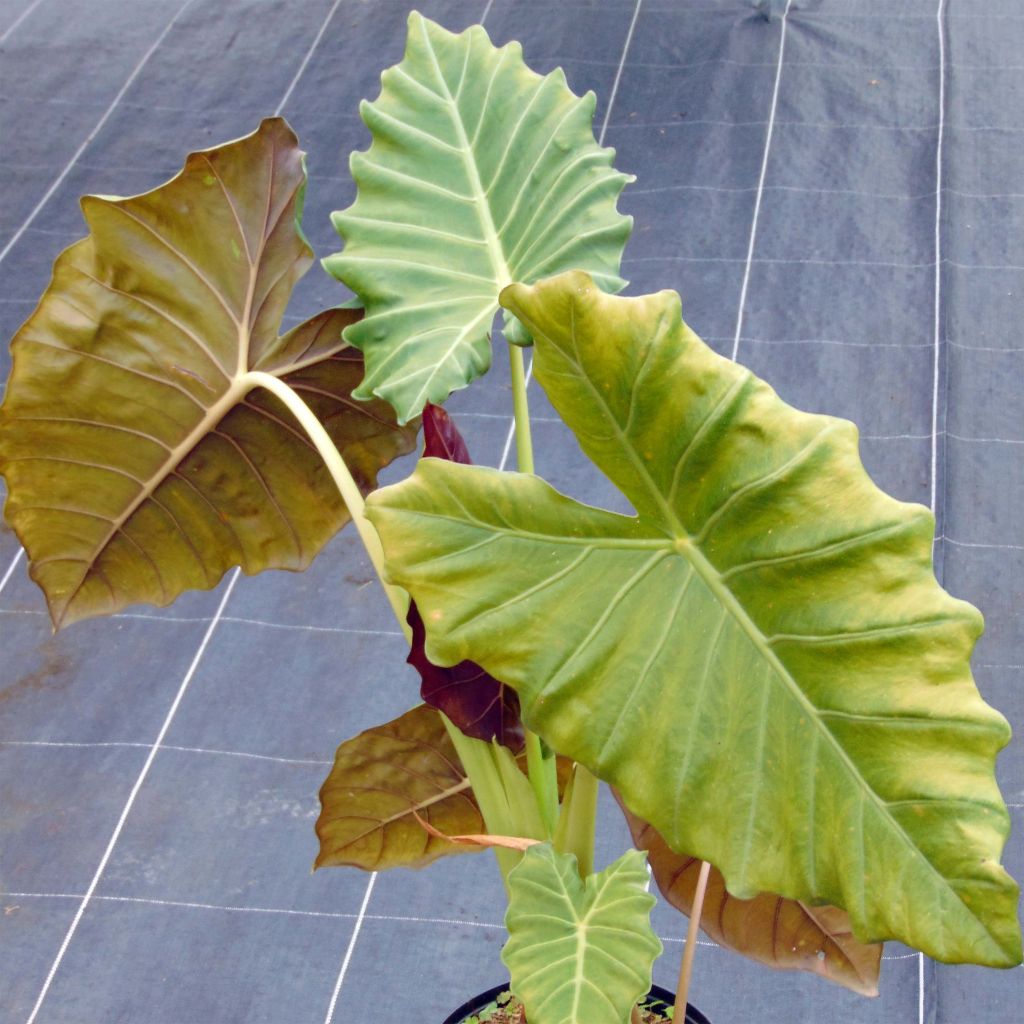

Alocasia Mayan mask - Oreille d'éléphant
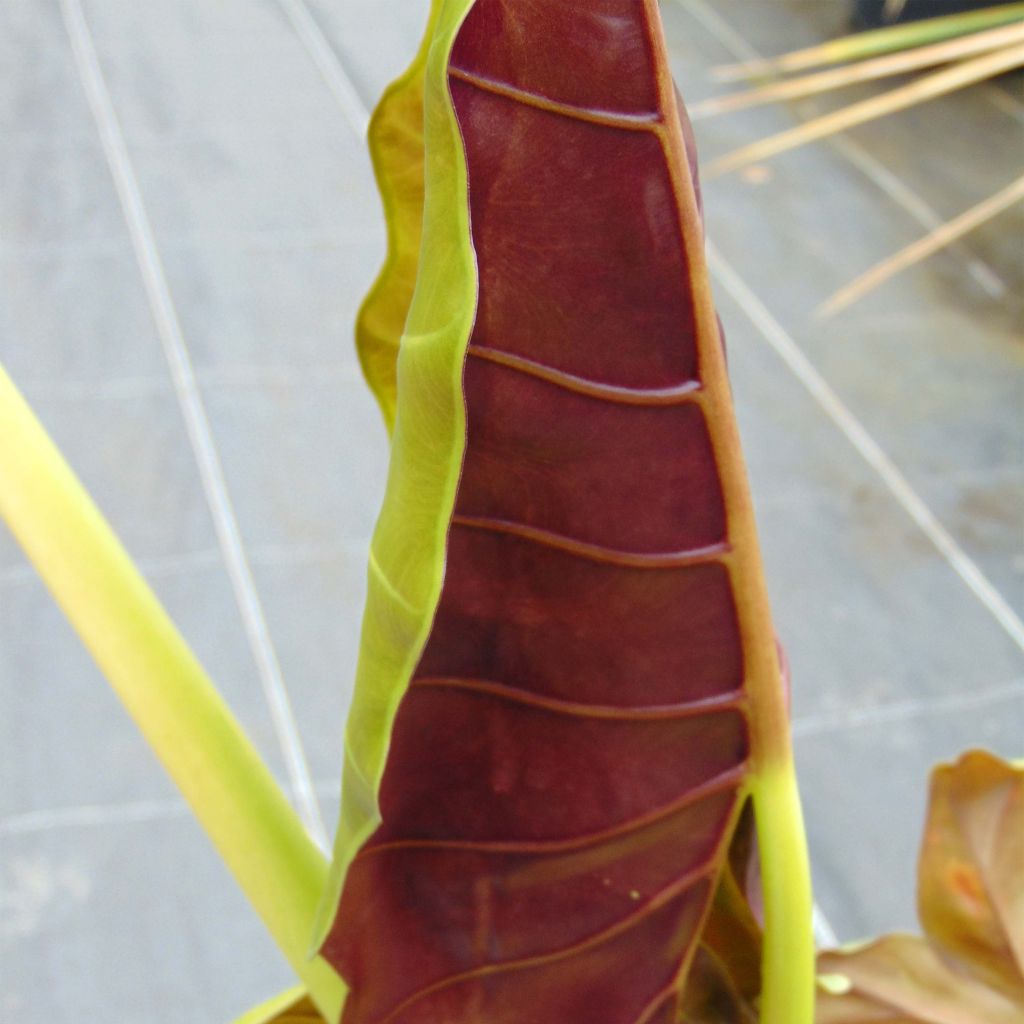

Alocasia Mayan mask - Oreille d'éléphant
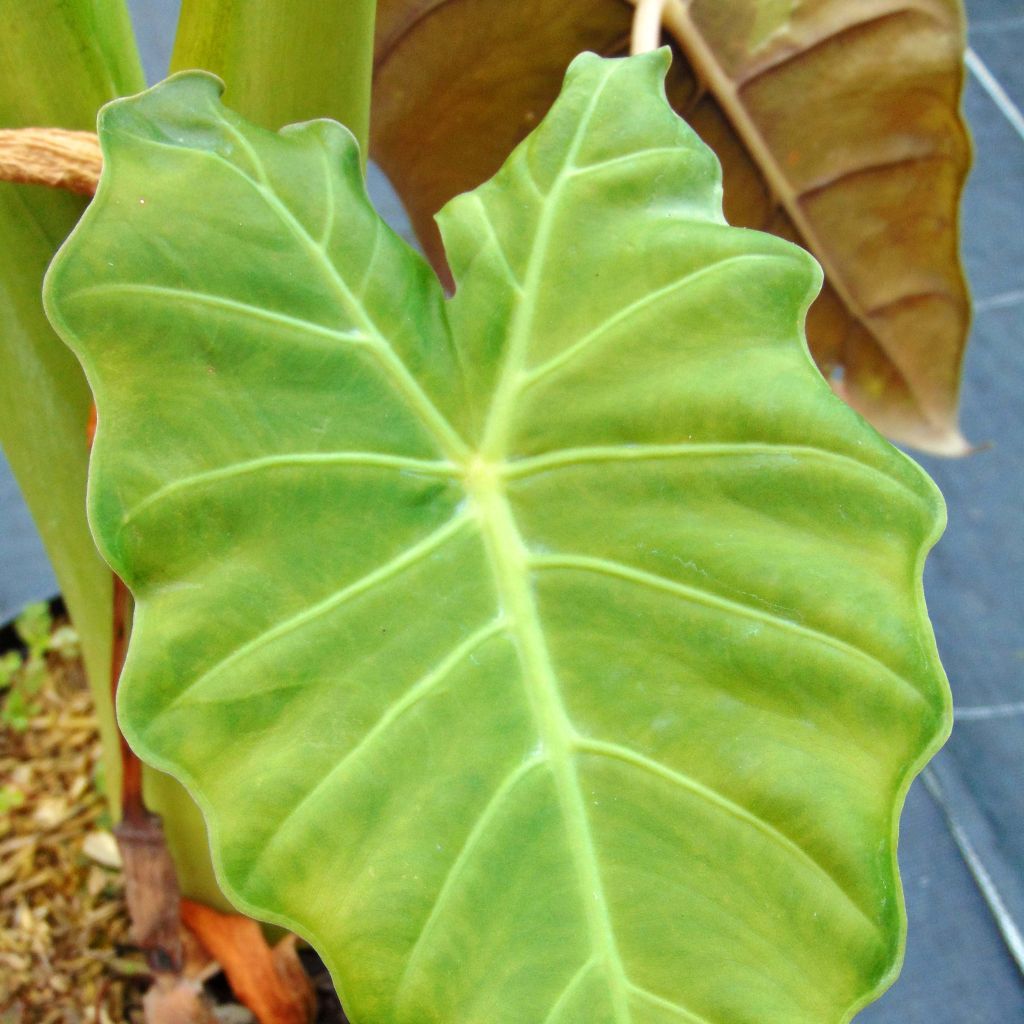

Alocasia Mayan mask - Oreille d'éléphant
Alocasia Mayan Mask
Alocasia odora x amazonica Mayan mask
Upright Elephant's Ear, Night-Scented Lily, Asian Taro, Giant Taro
This plant carries a 6 months recovery warranty
More information
We guarantee the quality of our plants for a full growing cycle, and will replace at our expense any plant that fails to recover under normal climatic and planting conditions.
From €5.90 for pickup delivery and €6.90 for home delivery
Express home delivery from €8.90.
Does this plant fit my garden?
Set up your Plantfit profile →
Description
Alocasia Mayan Mask, also known as elephant's ear, is a hybrid perennial plant with vigorous growth, capable of regenerating from the stump after experiencing short freezes down to around -8°C (17.6 °F). This recent variety is simply stunning with its giant leaves, bright green and deeply veined, whose reverse side seems lacquered with metallic paint in shades of purple, violet, and chocolate. Its cone-shaped inflorescence, called a spathe, recalls its relation to the more familiar Arums. This superb tropical plant will thrive in a bright interior with a humid and warm atmosphere, but it can also be grown in the ground, in partial shade, in regions spared from frost.
Native to Southeast Asia, Alocasias are plants for hot and humid tropical climates and partial shade. While they are magnificent, they can sometimes be difficult to acclimatise to our interiors, where the air is too dry. Alocasia Mayan Mask is an American horticultural hybrid introduced in 2012. It is a rhizomatous perennial plant related to Arums and belonging to the same family as Araceae. Its original habitat consists of tropical forests populated by tall trees and bathed in a humid atmosphere where temperatures do not drop below 20°C (68 °F). It is a truly imposing plant, developing from a tuberous rhizome, forming a scaly corm covered with thick skin. The mature plant will reach a height of about 2m (6-7 ft) with a diameter of 1m (3 ft), depending on the growing conditions. It forms an upright clump from which long fleshy petioles emerge, carrying immense shiny leaves, medium green on top, distinctly brown-red-violet underneath, thick and inclined outward, reaching a length of 2m (6-7 ft) and a width of 40cm (16 in). The heart-shaped lamina is traversed by deep veins, and occasional small incisions appear near the central vein, creating random patterns. The leaf surface allows water to slide off. During its growth the plant branches out from the base, allowing it to remain elegant. By removing an old leaf, two new ones take its place. The inflorescence, consisting of a spathe and a pale yellow-green spadix, 20cm (8 in) long, appears only rarely and late in cultivation, on mature specimens.
Alocasia can be grown in containers and overwintered in a veranda. Its hardiness could potentially allow it to withstand the mildest Mediterranean or oceanic climates, but air and soil dryness are limiting factors. This lush perennial will bring a strongly exotic touch when planted in a partially shaded area, paired with bamboo, a cycad, a Tetrapanax papyrifer, a banana tree, or even hibiscus. It will stand out as a focal point in a contemporary or exotic design, whether planted on a terrace in a large container or on the banks of a water feature. This voracious plant gets along well with arums, banana trees, or tree ferns, whose magnificence recalls ancient forests.
Report an error about the product description
Alocasia Mayan Mask in pictures
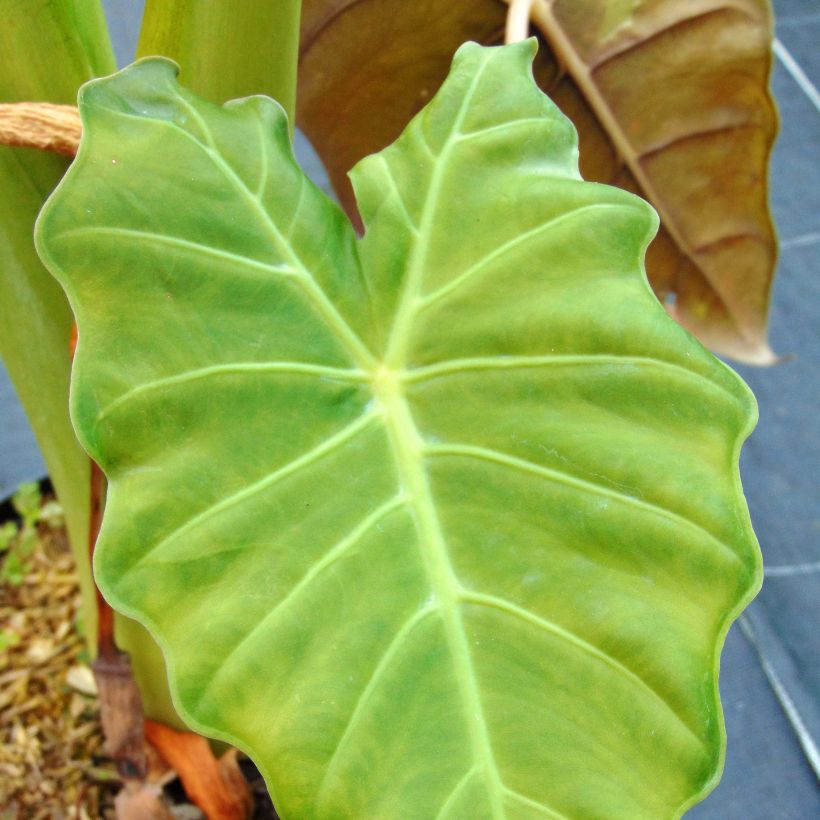

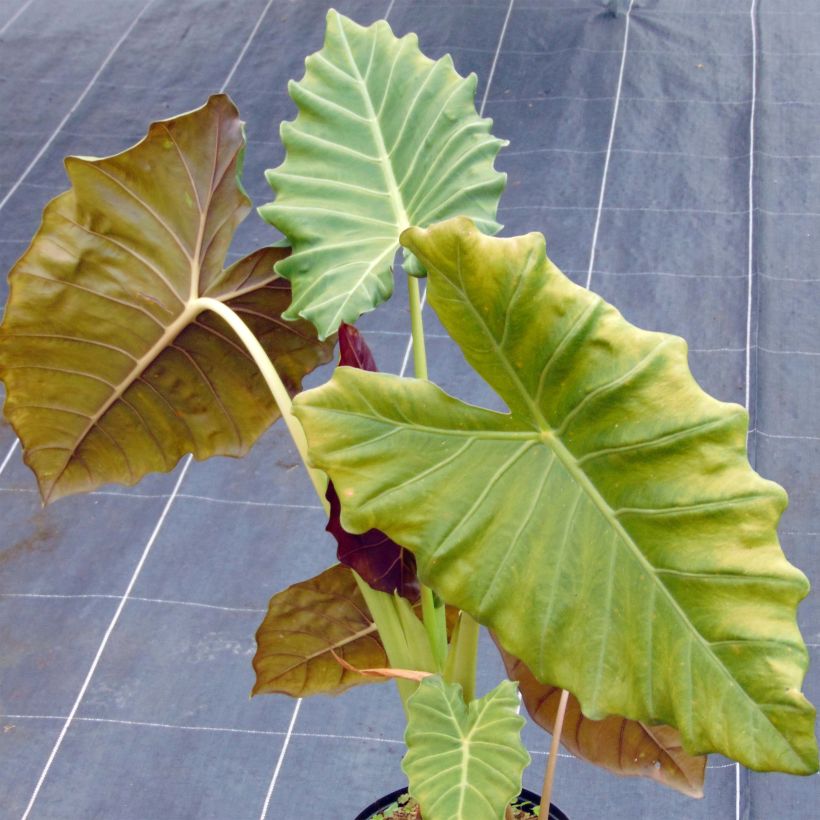

Plant habit
Flowering
Foliage
Safety measures
Botanical data
Alocasia
odora x amazonica
Mayan mask
Araceae
Upright Elephant's Ear, Night-Scented Lily, Asian Taro, Giant Taro
Cultivar or hybrid
atteintescutaneomuqueuses
Cette plante peut provoquer l'apparition de réactions cutanées indésirables, une atteinte des yeux, ou des difficultés respiratoires si elle est ingérée.
Ne la plantez pas là où de jeunes enfants peuvent évoluer. Evitez tout contact avec la peau: privilégiez l'emploi de gants pour la manipuler. En cas de contact, lavez-vous soigneusement les mains et rincez abondamment à l'eau la zone concernée. Lavez les vêtements entrés en contact. En cas de réaction cutanée, contactez votre médecin ou le centre antipoison le plus proche de chez vous. En cas d'atteinte étendue ou de difficultés respiratoires, appelez immédiatement le 15 ou le 112.Pensez à conserver l'étiquette de la plante, à la photographier ou à noter son nom, afin de faciliter le travail des professionnels de santé.
Davantage d'informations sur https://plantes-risque.info
Planting and care
Place your Alocasia in a bright indoor location, or preferably in partial shade if outdoors to avoid foliage burn. They require a moist to wet, fertile, and humus-rich soil and appreciate a nitrogen-rich fertiliser, such as grass clippings. You can plant your Alocasia in large containers, with regular and generous watering during the growing season, and reduced watering in winter. If the atmosphere is too dry in winter, the plants may be susceptible to attacks from scale insects and red spiders. Usually grown as greenhouse or conservatory plants, they are actually perennials that are not very hardy, depending on the variety. In frost-free regions, it is possible to attempt growing them in the ground. In autumn, place a thick layer of mulch around the base to protect the rootstock from the cold. The foliage may completely disappear, but the plant should regrow from the stump as soon as temperatures increase. If the soil becomes waterlogged in winter, the rootstock may rot, so it is important to ensure proper drainage. Watch out for attacks from slugs and snails, which enjoy feasting on the young leaves.
Planting period
Intended location
Care
This item has not been reviewed yet - be the first to leave a review about it.
Haven't found what you were looking for?
Hardiness is the lowest winter temperature a plant can endure without suffering serious damage or even dying. However, hardiness is affected by location (a sheltered area, such as a patio), protection (winter cover) and soil type (hardiness is improved by well-drained soil).

Photo Sharing Terms & Conditions
In order to encourage gardeners to interact and share their experiences, Promesse de fleurs offers various media enabling content to be uploaded onto its Site - in particular via the ‘Photo sharing’ module.
The User agrees to refrain from:
- Posting any content that is illegal, prejudicial, insulting, racist, inciteful to hatred, revisionist, contrary to public decency, that infringes on privacy or on the privacy rights of third parties, in particular the publicity rights of persons and goods, intellectual property rights, or the right to privacy.
- Submitting content on behalf of a third party;
- Impersonate the identity of a third party and/or publish any personal information about a third party;
In general, the User undertakes to refrain from any unethical behaviour.
All Content (in particular text, comments, files, images, photos, videos, creative works, etc.), which may be subject to property or intellectual property rights, image or other private rights, shall remain the property of the User, subject to the limited rights granted by the terms of the licence granted by Promesse de fleurs as stated below. Users are at liberty to publish or not to publish such Content on the Site, notably via the ‘Photo Sharing’ facility, and accept that this Content shall be made public and freely accessible, notably on the Internet.
Users further acknowledge, undertake to have ,and guarantee that they hold all necessary rights and permissions to publish such material on the Site, in particular with regard to the legislation in force pertaining to any privacy, property, intellectual property, image, or contractual rights, or rights of any other nature. By publishing such Content on the Site, Users acknowledge accepting full liability as publishers of the Content within the meaning of the law, and grant Promesse de fleurs, free of charge, an inclusive, worldwide licence for the said Content for the entire duration of its publication, including all reproduction, representation, up/downloading, displaying, performing, transmission, and storage rights.
Users also grant permission for their name to be linked to the Content and accept that this link may not always be made available.
By engaging in posting material, Users consent to their Content becoming automatically accessible on the Internet, in particular on other sites and/or blogs and/or web pages of the Promesse de fleurs site, including in particular social pages and the Promesse de fleurs catalogue.
Users may secure the removal of entrusted content free of charge by issuing a simple request via our contact form.
The flowering period indicated on our website applies to countries and regions located in USDA zone 8 (France, the United Kingdom, Ireland, the Netherlands, etc.)
It will vary according to where you live:
- In zones 9 to 10 (Italy, Spain, Greece, etc.), flowering will occur about 2 to 4 weeks earlier.
- In zones 6 to 7 (Germany, Poland, Slovenia, and lower mountainous regions), flowering will be delayed by 2 to 3 weeks.
- In zone 5 (Central Europe, Scandinavia), blooming will be delayed by 3 to 5 weeks.
In temperate climates, pruning of spring-flowering shrubs (forsythia, spireas, etc.) should be done just after flowering.
Pruning of summer-flowering shrubs (Indian Lilac, Perovskia, etc.) can be done in winter or spring.
In cold regions as well as with frost-sensitive plants, avoid pruning too early when severe frosts may still occur.
The planting period indicated on our website applies to countries and regions located in USDA zone 8 (France, United Kingdom, Ireland, Netherlands).
It will vary according to where you live:
- In Mediterranean zones (Marseille, Madrid, Milan, etc.), autumn and winter are the best planting periods.
- In continental zones (Strasbourg, Munich, Vienna, etc.), delay planting by 2 to 3 weeks in spring and bring it forward by 2 to 4 weeks in autumn.
- In mountainous regions (the Alps, Pyrenees, Carpathians, etc.), it is best to plant in late spring (May-June) or late summer (August-September).
The harvesting period indicated on our website applies to countries and regions in USDA zone 8 (France, England, Ireland, the Netherlands).
In colder areas (Scandinavia, Poland, Austria...) fruit and vegetable harvests are likely to be delayed by 3-4 weeks.
In warmer areas (Italy, Spain, Greece, etc.), harvesting will probably take place earlier, depending on weather conditions.
The sowing periods indicated on our website apply to countries and regions within USDA Zone 8 (France, UK, Ireland, Netherlands).
In colder areas (Scandinavia, Poland, Austria...), delay any outdoor sowing by 3-4 weeks, or sow under glass.
In warmer climes (Italy, Spain, Greece, etc.), bring outdoor sowing forward by a few weeks.


































